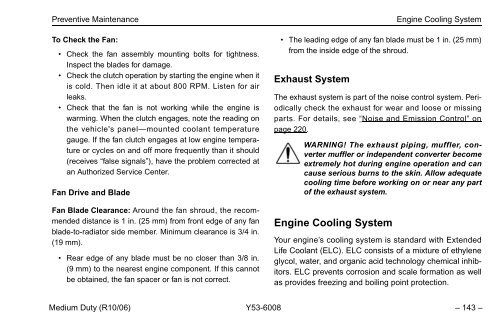Peterbilt Medium Duty Trucks Operator's Manual after 1-07
Peterbilt Medium Duty Trucks Operator's Manual after 1-07
Peterbilt Medium Duty Trucks Operator's Manual after 1-07
You also want an ePaper? Increase the reach of your titles
YUMPU automatically turns print PDFs into web optimized ePapers that Google loves.
Preventive Maintenance<br />
To Check the Fan:<br />
• Check the fan assembly mounting bolts for tightness.<br />
Inspect the blades for damage.<br />
• Check the clutch operation by starting the engine when it<br />
is cold. Then idle it at about 800 RPM. Listen for air<br />
leaks.<br />
• Check that the fan is not working while the engine is<br />
warming. When the clutch engages, note the reading on<br />
the vehicle's panel—mounted coolant temperature<br />
gauge. If the fan clutch engages at low engine temperature<br />
or cycles on and off more frequently than it should<br />
(receives “false signals”), have the problem corrected at<br />
an Authorized Service Center.<br />
Fan Drive and Blade<br />
Fan Blade Clearance: Around the fan shroud, the recommended<br />
distance is 1 in. (25 mm) from front edge of any fan<br />
blade-to-radiator side member. Minimum clearance is 3/4 in.<br />
(19 mm).<br />
• Rear edge of any blade must be no closer than 3/8 in.<br />
(9 mm) to the nearest engine component. If this cannot<br />
be obtained, the fan spacer or fan is not correct.<br />
Engine Cooling System<br />
• The leading edge of any fan blade must be 1 in. (25 mm)<br />
from the inside edge of the shroud.<br />
Exhaust System<br />
The exhaust system is part of the noise control system. Periodically<br />
check the exhaust for wear and loose or missing<br />
parts. For details, see “Noise and Emission Control” on<br />
page 220.<br />
WARNING! The exhaust piping, muffler, converter<br />
muffler or independent converter become<br />
extremely hot during engine operation and can<br />
cause serious burns to the skin. Allow adequate<br />
cooling time before working on or near any part<br />
of the exhaust system.<br />
Engine Cooling System<br />
Your engine’s cooling system is standard with Extended<br />
Life Coolant (ELC). ELC consists of a mixture of ethylene<br />
glycol, water, and organic acid technology chemical inhibitors.<br />
ELC prevents corrosion and scale formation as well<br />
as provides freezing and boiling point protection.<br />
<strong>Medium</strong> <strong>Duty</strong> (R10/06) Y53-6008 – 143 –
















